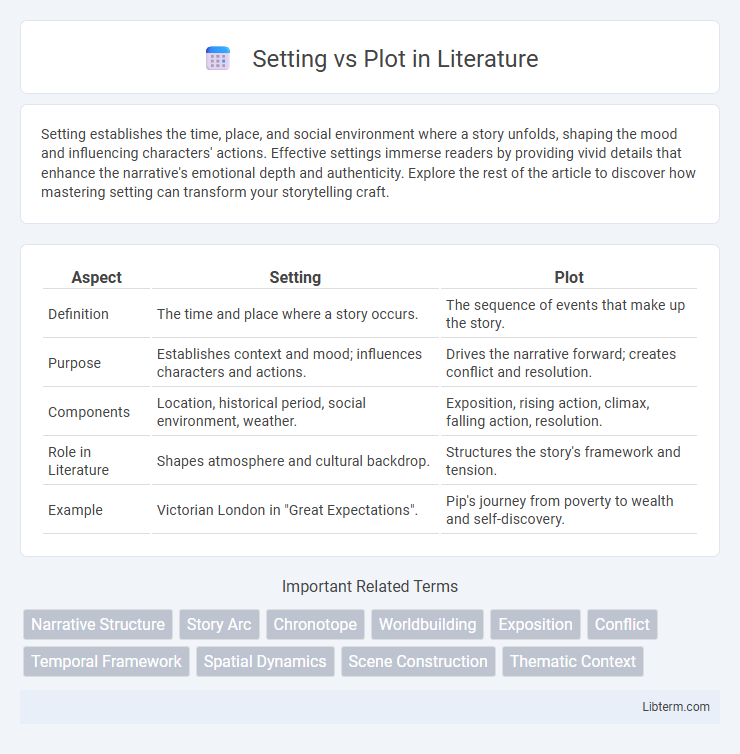Setting establishes the time, place, and social environment where a story unfolds, shaping the mood and influencing characters' actions. Effective settings immerse readers by providing vivid details that enhance the narrative's emotional depth and authenticity. Explore the rest of the article to discover how mastering setting can transform your storytelling craft.
Table of Comparison
| Aspect | Setting | Plot |
|---|---|---|
| Definition | The time and place where a story occurs. | The sequence of events that make up the story. |
| Purpose | Establishes context and mood; influences characters and actions. | Drives the narrative forward; creates conflict and resolution. |
| Components | Location, historical period, social environment, weather. | Exposition, rising action, climax, falling action, resolution. |
| Role in Literature | Shapes atmosphere and cultural backdrop. | Structures the story's framework and tension. |
| Example | Victorian London in "Great Expectations". | Pip's journey from poverty to wealth and self-discovery. |
Defining Setting and Plot
Setting defines the time, place, and environment where a story unfolds, shaping the mood and context for characters' actions. Plot refers to the structured sequence of events and conflicts that drive the narrative from beginning to end. Understanding the distinction clarifies how setting influences atmosphere while plot organizes the story's progression.
Key Differences Between Setting and Plot
Setting refers to the time and place where a story occurs, establishing the backdrop and environment that influence characters' actions. Plot is the sequence of events and actions that drive the narrative forward, creating conflict and resolution. While setting provides context and mood, plot focuses on the structure and progression of the story's events.
How Setting Influences Plot Development
Setting shapes plot development by providing the temporal, geographical, and cultural context that drives character actions and narrative events. The environment's mood and constraints, such as a dystopian city or isolated island, create obstacles and opportunities that directly influence the story's trajectory. Detailed sensory descriptions of setting enhance immersion, making plot twists and conflicts more compelling and believable within the established world.
The Role of Setting in Story Atmosphere
Setting shapes the story's atmosphere by establishing time, place, and environment, which influence the mood and tone throughout the narrative. Detailed descriptions of weather, lighting, and surrounding elements immerse readers in the world, enhancing emotional engagement and thematic depth. A well-crafted setting supports the plot by reinforcing the story's emotional impact and guiding readers' perceptions of characters and events.
Plot Structure: Elements and Organization
Plot structure organizes the sequence of events in a narrative through key elements such as exposition, rising action, climax, falling action, and resolution. Each element serves a distinct function, with exposition introducing characters and setting, rising action building conflict, the climax presenting the story's turning point, falling action easing tension, and resolution providing closure. Effective plot organization ensures coherent storytelling by strategically arranging these components to maintain pacing, suspense, and thematic development.
Interplay Between Setting and Plot
The interplay between setting and plot shapes the narrative's direction by grounding events in a specific time and place that influences characters' actions and conflicts. Settings like dystopian cities or historical eras provide contextual constraints and opportunities that drive plot development and heighten tension. This dynamic relationship ensures that the environment is not just a backdrop but a catalyst for the unfolding story.
Setting as a Catalyst for Plot Events
Setting functions as a crucial catalyst for plot events by establishing the environment that challenges characters and influences their decisions. The geographical location, time period, and social circumstances shape the conflicts and opportunities, driving the narrative forward. When settings evoke specific moods or constraints, they directly prompt pivotal actions and twists in the storyline.
Examples of Setting Driving the Plot
The setting in *Macbeth* transforms the gloomy, stormy Scottish Highlands into a backdrop that amplifies the play's dark and ominous tone, directly influencing Macbeth's descent into ambition and murder. In *The Great Gatsby*, the opulent Jazz Age New York City and its contrasting Valley of Ashes drive the plot by highlighting the social stratifications and moral decay central to the story's conflict. Similarly, the dystopian, oppressive environment of Panem in *The Hunger Games* shapes Katniss Everdeen's struggle for survival and rebellion, proving how setting can actively propel narrative developments.
Common Mistakes: Confusing Setting with Plot
Confusing setting with plot often results in narratives where the backdrop overshadows the sequence of events, leading to stories that feel static or aimless. Setting refers to the time, place, and environment in which the story unfolds, while plot centers on the causally linked events that drive the narrative forward. Writers must distinguish between the descriptive elements of setting and the dynamic actions of plot to create engaging, coherent stories.
Crafting Stories: Balancing Setting and Plot
Crafting compelling stories requires a delicate balance between setting and plot, as the setting grounds the narrative in a vivid world while the plot drives the characters' actions and conflicts. Effective storytelling weaves detailed environments with dynamic events, ensuring the setting enhances the plot's emotional and thematic depth without overshadowing the storyline. Mastering this balance enriches reader engagement, making the story immersive and impactful.
Setting Infographic

 libterm.com
libterm.com